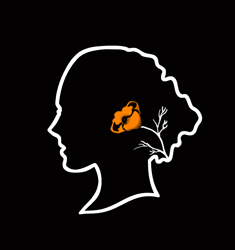“I didn’t have to change when I came here. I think California allows you to be who you are.”
ElseMarie Lund Petersen, oil on canvas 18x24 by Holli Harmon
ElseMarie Petersen
ElseMarie came to Solvang as a tourist from Denmark in 1987. On that trip she met Aaron Petersen, who she married one year later. Aaron’s family has deep roots in the Santa Ynez Valley. Together they have raised four children there and have built several successful businesses, including Chomp and the Greenhouse Cafe. "We like to eat dinner together as a family but sometimes it's hard when you run two restaurants."
When their children were young, ElseMarie and Aaron made time for extended travel in Europe. They spent two months each in Denmark, France and Italy, and the children gained an appreciation for their own family history as well as for other cultures. They learned new languages and skills that have been useful in their lives and professions.
Growing up in Denmark, ElseMarie heard many stories about Solvang from her father who participated in a farm exchange program; he worked for two years on an Alamo Pintado property in the 1950s. They discovered her mother had relatives in Solvang when her family first visited Solvang together when she was a teenager.
Reflecting on the differences in life between Denmark and Solvang, she observes, “Denmark is a little more traditional. You always wish you could slow things down here. We had dinners that lasted until 1 or 2 a.m. Here, people leave at 9:30 or 10:30.” ElseMarie remembers long dinners and chatting with friends in the kitchen; after the dishes were done, conversations would continue over dessert long into the night.
In addition to working with her family's business, ElseMarie has recently become the manager of Copenhagen House. She is passionate about Danish design. "Danish architecture and designs are used all over the world." The Lego Group, Arne Jacobsen's Egg Chairs, and Louis Poulsen lighting designs are all examples of a Danish aesthetic that focuses on functional design and clean lines. This aesthetic was influenced by the Bauhaus school and extended to building design as well as furniture. Famous examples of Danish design in modern architecture are the Copenhagen Opera House and Sydney Opera House.
ElseMarie notes, "In Danish houses, the walls are often white; maybe this is because it is often dark or rainy outside. Danes have a fondness for hyggeligt; the translation to English is like coziness indoors." This is sometimes described as a feeling of conviviality, such as that found in fireside chats or over a shared meal. She observes that here in Solvang her family likes to spend time outdoors too. She is also a road cyclist and observes, "The Santa Ynez Valley is the most beautiful place," a sentiment echoed by all of our Portrait subjects that call the SYV home.
Thinking back to her first memories of Solvang in the seventies, she remembers, "There wasn't as much tourism.” Although most visitors come from southern California, Solvang is known around the world, and has over a million visitors each year. Many of the towns of the central coast depend on tourism as an industry. “Even though there's more traffic now we embrace tourism but we still have a small town feel. We have a lot of families here; people are involved in their children's lives. There is a nice sense of community.”
She shares pride in her adopted hometown of Solvang and the organizations that work to promote Danish culture in our region, such as the Danish Sisterhood. "I didn't have to change when I came here. I think California allows you to be who you are."
To experience Danish culture close to home, from learning about pioneers in the valley to sampling delectable baked goods, fine beers and savory meals to demonstrations of artisanal crafts, music and dance, visit Solvang during Danish Days, or anytime!
By Katherine Bradford



